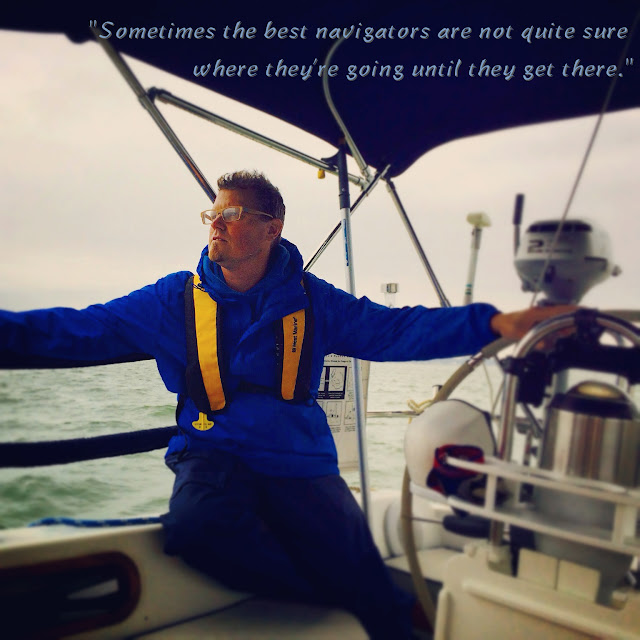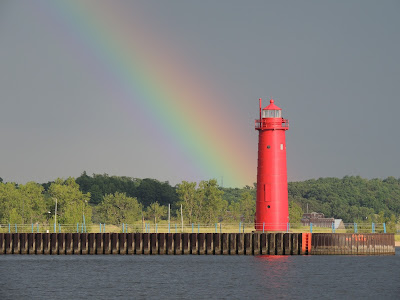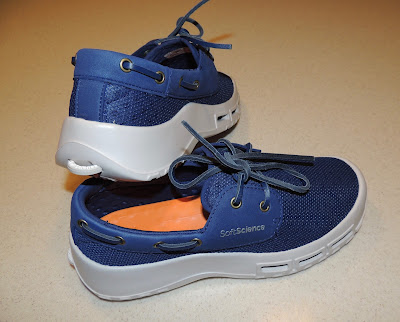When I think of the cruising lifestyle, I generally picture a sturdy 35'+ sailboat capable of serving as a liveaboard and hopping among idyllic anchorages sprinkled with a few marina days in between to recharge and restock. But my myopic view neglects a whole other niche of cruisers who can load up their sailboat on a trailer and tow it down the road to a faraway inland lake or a port many latitudes to the south. It seems trailerable cruising sailboats could also be a good fit for a weekend warrior on a budget who doesn't want to deal with seasonal marina slip fees or days long sails between destinations. In any case, I should know better since
my first sailboat (a Helms 25) was in fact a trailer sailer, although I didn't use it as such.
![]() |
| Here's a throwback to s/v Hannabel, our Helms 25 and very first boat |
Not all sailing adventures are found by crossing oceans. Some are waiting across multiple counties on the other end of the interstate. And so, from my non-trailer-sailer perspective, here's an overview of what I'd look for in
trailer-sailer and a few that I think are exceptionally capable of serving as cruising platforms for road warriors.
First, let's consider what makes a sailboat trailerable in the first place:
Keel design: Deep fin keels and long fixed-blade rudders will make loading and unloading from a trailer difficult, if not impossible. Even if you have a trailer capable of holding a sailboat with a deep draft fin keel, finding a launch ramp that's steep and deep enough to handle it is a difficult task. So the alternatives become either a shallow draft full keel or some variation of a lifting keel, swing keel or centerboard (Or maybe a rare twin bilge?). Rudders will likewise need to either swing, lift or be easily removable. To get this in a trailerable design, you might have to give up some seaworthiness or offshore readiness, but you’ll be rewarded with a sailboat that not only fits on a trailer but also is able to access skinny water and be beached for overnighting or exploring ashore. After all, you don't need a dinghy if you can put your bow on the beach.
Beam: To fit on most roads and fall within regulations for most states, trailerable boats need a beam of 8’6” or less. Of course wider loads are sometimes allowable with special permits, but who needs that hassle if you’re planning to trailer frequently. A narrow beam compromises cockpit/cabin space and possibly performance, but it’s a tradeoff you’ll have to make to maintain portability.
Weight: Large cars capable of towing a decent size boat are seemingly a thing of the past. Today’s mid/full-size SUVs can tow from about 2,000 to 5,000 pounds. Take the popular Ford Explorer for example, which has a max towing capacity of 5,000 pounds. If you plan to haul something heavier like a Nor’Sea 27 (~8,100 lbs), you’ll need a pick-up truck.
Mast/Rigging: Obviously the mast has to come down when the sailboat is on the trailer and headed down the road. So, just how easy is it to step and unstep the mast and get the rigging ready to roll? Will you need a gin pole or some other contraption to raise the mast? Or perhaps the manufacturer has engineered a good, efficient system for raising and lowering the mast and rigging the boat frequently.
Accommodations: This one seems like a no-brainer, but you’ll have to make some tradeoffs in accommodations in order to get the size/weight acceptable for trailering. Many trailer sailers just provide the basics: berths for two, porta potti and small sink and an ice box. If you require a fully enclosed private head with a holding tank, berths for 3+, refrigeration, shore power, standing headroom and other amenities your options for trailers sailers will begin to get limited.
Other considerations: While there are some trailer sailers that have inboard engines, most have outboards. There are a lot positives for having an outboard on a trailer sailer, including less weight, space savings, cheaper replacement cost and ease of maintenance/storage. But you may also have to deal with cavitation if you end up motoring in seas big enough to cause hobby horsing motions. And inboards are typically better for efficient 12-volt charging if that matters to you. One other consideration is that some trailer sailers come with oars and oar locks, so a motor may not be necessary at all. Given the small size of most of these boats, it’s probably feasible to add oar locks to any of them.
Ok, let’s get on with the fun part of this post…talking about actual sailboats! The following are some boats I’d seriously consider if cruising and trailerability were my top two priorities:
Com-Pac 23 (23’ LOA, 8’ beam, 2’3” draft, 3000 lbs.): Com-Pac and the Hutchins family have been building sailboats for a long time. The 23 was first launched in 1979 and is still being built today, which is a testament to this model’s popularity and quality. At first glance, the Com-Pac 23 appears to be a much larger boat than it actually is. Her overall shape and styling give the impression of a 30-footer. It was designed from day one as a trailer sailer, so you’ll get the benefit of only 2’3” from the shoal keel, but you might give up some weatherly sailing capability. Still, being such a long-lived model means you’ve probably got plenty of examples to choose from and can even find an inboard diesel version or the pilothouse version if you’re patient. More info here:
ComPacYachts.comMontgomery 17 (17’2” LOA, 7’4” beam, 1’9” up/3’ down draft, 1600 lbs.): This is an accomplished little sailboat. Consider that Montgomery 17’s have crossed from California to Hawaii and Cape Hatteras to San Diego via the Panama Canal. And at least one intrepid solo sailor has gone from California to Vanuatu with plans to continue on crossing the Indian Ocean and rounding the Cape of Good Hope [I haven’t been able to determine if
s/v Starwanza and Willi made it further, but you might be able to via Google]. In any case, this is another hit from the mind and pen of Lyle Hess. If you’re looking for a small, dry and seaworthy trailer sailer, the Montgomery 17 should be on your list. More info here:
MontgomeryBoats.comMacGregor 26 (25’10” LOA, 7’9” beam, 12” board up/5’9” board down draft, 2550 lbs.): I’ll get it out of the way early – This is a budget boat, but there’s nothing at all wrong with that. In fact, most of us are budget sailors and many start or stay in the MacGregor 26 end of the budget spectrum. This might also be a boat for those that like to sail, but occasionally want to bring the boat up on plane with an outboard and motor at speeds of ~20mph. MacGregor’s water ballast system allows their boats to be lightweight for trailering or planning with a relatively small engine, but also take on ballast for sailing and stability. Whatever you think of the MacGregor 26, there’s certainly a market for them given that company has built over 36,000 boats. More info here:
MacGregor26.comSirius 21/22 (21’ 2” LOA, 7’11” beam, 16” up/5’ down draft, 2000 lbs.): Being the first production-built ballasted cruising boat with positive flotation is one of the Sirius 21s claims to fame. [Note – The West Wight Potter 19 may actually stake this claim] This Canadian built sailboat had closed-cell foam injected into gaps and between the hull and liner which added buoyancy, but also provides stiffness and sound/thermal insulation. First produced in 1977, the Sirius 21 later became the Sirius 22 when a reverse transom was added. Other than an additional 10 inches and a bit more buoyancy, the 21 and 22 are the same. These Sirius sailboats are fitted with a lifting keel (A few fixed keel 22s were produced before the builder went out of business in 1987), an outboard, a generous cockpit and standing headroom in the cabin under the pop-top. While I haven’t been aboard one, these are said to be fun, spirited sailboats with a good turn of speed. More info here:
Boats.com Sirius 21/22 ReviewNimble Kodiak (27’3” LOA, 8’6” beam, 1’10” board up/4’4” board down draft, 3640 lbs.): You’re likely not buying a Nimble Kodiak because of the way she looks. Then again, I won’t judge you if you’re drawn to the boxy pilothouse and green hull sides of this double-ender. But the all-season comfort of the pilothouse and standing headroom might be appealing. So might the “tiny trawler” feel. The stubby rig and big windage on deck likely mean the Kodiak isn’t the best sailing boat on my list, but her construction is said to be stout. And she’s aptly named because I can imagine more than a few have plied Alaska’s Inside Passage. This is another long running model, which means you’ve got options with the Kodiak – sloop or yawl rig, centerboard or fixed keel, outboard or inboard. More info here:
NimbleBoatWorks.comNor'Sea 27 (27’ LOA, 8’ beam, 3’10” draft, 8100 lbs.): The Nor'Sea 27 is the largest boat on my list. In fact, it’s a bit large and heavy for some, but considering that one day the Nor'Sea 27 can depart the middle of the United States and be ripping down the interstate at 55mph (on a trailer, of course) and the next she can be headed offshore from San Diego harbor enroute to the Marquesas thousands of miles away, I had to include it. This genuine bluewater sailboat was conceived from the beginning as a trailer sailer. Designer Lyle Hess was challenged to build a trailerable bluewater boat and he delivered. Hess is quoted as saying; "Any boat that points her bow out to sea should be designed so that the crew need not worry about a safe return - no matter what tricks the weather may play". And so it is with the Nor'Sea 27. If that isn't enough lure, take a peak below decks and you'll see fine craftsmanship and very cruiser-friendly layouts. She's available in both aft and center cockpit configurations with lots of space and plenty of berths. Center cockpits usually look funky in small sailboats, but amazingly Hess makes the Nor'Sea 27 gorgeous in addition to being trailerable and bluewater capable. What's the trade-off? Price. New complete boats are still available from Nor'Sea for about $170k, but they've been in production since 1977 so the pre-owned market is an option with prices starting in the $30k's. More info here:
Nor'SeaYachts.comWest Wight Potter 19 (18’9” LOA, 7’6” beam, 6” up/3’7” down draft, 1225 lbs.): Berths for four and a full galley feels like a lot for just a 19-footer. It is, but you’ll still occasionally curse the 5’ headroom for the back aches that it might cause. The Potter 19’s keel design retracts vertically into the hull and makes her easily beachable. It’s also packed with closed-cell foam in the fore and aft ends, making it unsinkable. Built since 1971 and still in production today, the Potter 19 is a popular classic that has aged well. Known for their solid construction, ease of handling and stability in a stiff breeze, it’s easy to include the West Wight Potter on my list of desirable trailer sailers. More info here:
WestWightPotter.comCal 25 (25’ LOA, 8’ beam, 4’ draft, 4000 lbs.): This one is stretch as a trailer sailer because of the keel, but if you’re willing to deal with some extra hassles (trailer tongue extender? Deep launch ramp? Etc.), the Cal 25 is a very affordable and proven boat for those who want to cruise and do some racing. While not an all-out race boat by any means, the Cal 25 is fun and relatively fast with active class associations in many parts of the United States. For a boat built between 1965 and 1976, these are as bulletproof as they come. The flush deck gives a unique look surpassed only by the looks you’ll get at the boat ramp when people see you backing down a 4’ deep keel. More info here:
C25 Class AssociationCatalina 22 (21’6” LOA, 7’6” beam, 1’6” up/5’ down draft, 2490 lbs.): As Catalina’s first boat the C22 must have widely surpassed Frank Butler’s initial sales expectations, having sold more 15,000 hulls since 1969. The original MkI was launched with a cast-iron swing keel, but all three versions (MkI, MkII & MkIII) could also be had with a fixed fin keel. Obviously trailer sailors will opt for the swing keel. There’s no single feature that stands out as exemplary other than to say the C22 is a simple boat to sail, maintain and own. Given the sheer number available on the used market and the support from the Catalina community and factory along with the aforementioned simplicity, it’s easy to see why the C22 is many a sailor’s first boat and a popular trailer sailer. More info here:
Catalina 22 National Sailing AssociationNorseboat 21.5(21’10” LOA, 7’1” beam, 1’6” up/3’10” down draft, 1900 lbs.): This is a stout looking little boat with a lapstrake hull and a snooty bow. That’s a lot of attitude in such a small package. If you’re looking to go cruising, you’ll want to look at the 21.5 “Cabin” model since Norseboat also makes “Open” and “Launch” versions. The rig is really cool – It’s a fully battened mainsail with a curved headboard, pivoting carbon mast and a furling genoa on a bowsprit. And how’s this for camping on a keel – Norseboat offers two different camping tents that protect the cockpit for additional sleeping/living area while cruising. More info here:
Norseboat.comWant more content and posts about sailboat design and specific boats?
Visit SFLF's Sailboat Reviews page.
![]() |
| The end! |







































